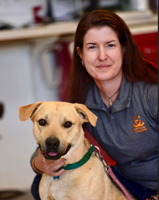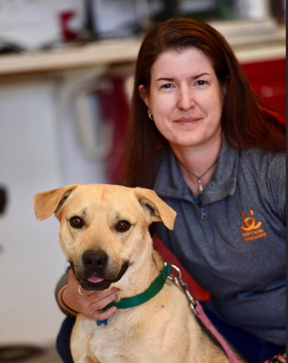
Dr. Erin Katribe 288

Photo by Molly Wald
Dr. Erin Katribe is shown with Beckham, a former Best Friends Animal Society shelter dog who has since been adopted.
The VIN News Service recently published a commentary titled "Has the no-kill movement increased animal suffering?" that raises concerns about the no-kill movement. The thrust of the authors' argument is that in order to achieve a "save rate" of 90% or higher, some shelters and rescue organizations house animals in unhealthy conditions, limit the numbers and kinds of animals they accept, and/or play accounting games.
The commentary paints a one-sided picture of the no-kill movement and fails to address many of the key components of no-kill. The programs that have been implemented as a result of this movement have saved hundreds of thousands of lives. No-kill is a goal that is attainable by all organizations if we work collectively and collaboratively to achieve it.
I'd like to share the view from Best Friends Animal Society, a national animal welfare nonprofit founded 35 years ago. Best Friends is a founder and leader in the no-kill movement, working along with other national organizations in the pursuit of saving lives. In 2016, Best Friends planted an ambitious stake in the ground: Every shelter and every community in the nation would achieve no-kill by 2025.
Regardless of whether a shelter subscribes to the no-kill wording and 90% benchmark, Best Friends believes the goal can be reached because increasing lifesaving should be a common objective that unites everyone involved in animal welfare.
Many of Best Friends' efforts address the very concerns outlined in the commentary and, through the leadership of Best Friends and many other important partners, thousands of shelters and communities across the country have already achieved no-kill, meaning they are saving the lives of 90% or more of the animals that enter their care.
What is 'no-kill'?
No-kill is more than a number. It is a philosophy that means saving all of the savable pets that enter our nation's shelters. Although there is no universal definition of "savable," no-kill adherents promote and follow a community ethic that means making a commitment to find homes for all healthy, treatable or rehabilitatable animals. Just as businesses use financial metrics to gauge improvement and success, using a benchmark to objectively measure shelters' lifesaving efforts provides accountability. A 90% save rate for all dogs and cats in a shelter system is a simple, effective method for measuring a community’s progress toward the goal of saving all of the savable pets. It's an important metric, and it is used in service of the core goal of the movement: working together to save the lives of every dog and cat who enters a shelter.
No-kill is achieved with programs that:
- Keep animals with their families instead of entering the shelter in the first place
- Adopt pets to new families
- Move animals to foster homes and out of the shelter
- Transfer animals to partner organizations to relieve the immediate burden on the shelter
- Address community cat issues by providing trap-neuter-return and/or shelter-neuter-return services
- Allow the shelter to become a community resource center
- Treat animals for medical conditions through innovative models, partnership with other organizations and veterinarians, and community engagement to help share the burden of treatment costs
- Provide behavior programming and enrichment for animals in the shelter to give them the tools to succeed in a home environment
- Utilize an adoption process that is transparent and counsels prospective adopters on the behavior, personality, and any medical conditions of an animal and allows the family to make an informed decision on whether the pet is a good fit
- Engage all stakeholders within a community (nonprofits, municipal shelters, rescue organizations) to take collective responsibility for lifesaving
- Engage the public and the community to become part of the lifesaving solution
What no-kill is not:
- Hoarding or keeping animals inhumanely
- Adopting out animals that are a safety risk to the community
- Not euthanizing an animal that is experiencing irremediable suffering
Why is no-kill so controversial?
No-kill has been controversial for many years and remains divisive within the animal welfare movement. One of the movement's biggest challenges has been a lack of comprehensive data and a general lack of transparency. Additionally, communities did not assume collective responsibility for lifesaving.
To solve this, Best Friends Animal Society engaged in years of national data collection to create what we call a community lifesaving dashboard. In the dashboard, each community and each shelter has a page providing its lifesaving data, as well as information about the shelter's programs and what support it still needs.
The dashboard debuted in 2019 and currently includes reported data from 3,229 shelters across the country. Shelter Animals Count maintains a similar voluntarily-reported dataset. The Best Friends dashboard additionally uses sophisticated methods developed by a team of data analysts to estimate data for shelters that have elected not to share their data. The dashboard also provides a unique interface for members of the public to interact with their local shelters and learn how to get involved in a way that will most effectively help their shelter and their community.
Further, the dashboard identifies no-kill communities, rather than just no-kill shelters. A community is defined using the U.S. Census Bureau's "place" designation, and generally is a city, town, village or borough. In some cases, unincorporated communities and Census-designated places are included, as well. More information is posted online on methodology and through dashboard FAQs.
It is only when we work together, transparently and collaboratively, that we can end the needless killing of pets in shelters.
Owner-requested euthanasia
Providing euthanasia at owners' requests, known as ORE, is a much-needed service that many shelters provide for low-income members of their communities. The commentary questioning tactics used in pursuit of the no-kill goal discusses the possibility of shelters using ORE to artificially reduce their non-ORE euthanasia numbers. It gives an example reported in the news of one shelter's staff advising any person surrendering their pet for rehoming to check the ORE box, without explaining the meaning of the acronym. That way, if the pet were euthanized, it would count as an ORE and not toward the calculation of the shelter's 90% save rate.
The unethical actions of one shelter are not representative of many shelters that offer this service as a way to end suffering. However, due in part to the lack of industry-wide standards or guidelines around owner-requested euthanasia practices, Best Friends Animal Society has elected to include all OREs in its save-rate calculations and determination of no-kill status for shelters and communities. This is a more objective and holistic way to evaluate the data. True euthanasia — that is, to end irremediable suffering — is justified. This is one of the reasons why the no-kill threshold is set at 90% instead of 100%. Therefore, it should be accounted for in a no-kill benchmark for shelters and communities.
No-kill language and the public
The commentary authors propose dropping the term "no-kill," calling it inflammatory, inaccurate and divisive. But unpublished research done for Best Friends by a nationally recognized firm shows that the public understands and supports no-kill; the term is motivating and compelling, particularly when it is understood that no-kill is more than a practice, but is a philosophy that guides our approach to sheltering and caring for animals in our communities. Because saving the lives of pets that enter our nation's shelters is a community ethic and requires efforts far beyond the walls of any one shelter, it is imperative that we use clear, concise and compelling messaging to garner the support of the public and of policymakers. Using the term "no-kill" achieves this, especially when we begin to measure our efforts in terms of entire no-kill communities.
No-kill communities
Another criticism of the commentary authors is that limited-admission shelters avoid accepting less-desirable pets in order to increase their save rates. That criticism becomes irrelevant when we evaluate no-kill efforts on a community-wide basis rather than examining the performance of individual shelters. Looking at the entire community means looking at all of its shelters, so every organization contributes to achieving the 90% benchmark, and each organization is held accountable. A no-kill community is one in which each brick-and-mortar shelter serving or located in a community individually has reached the 90% save rate. The two defining characteristics of no-kill communities are collective responsibility and collaboration. All stakeholders must work together to meet and sustain lifesaving.
Today, there are more than 4,000 no-kill communities in the United States, comprising more than 40% of the shelters in the country, and representing a wide range of demographics. Many more communities are rapidly approaching the no-kill benchmark. To be clear, a 90% save rate is the no-kill threshold, not the ceiling; the lifesaving rate for many communities is well above that threshold. There may be special circumstances in which a community successfully implements no-kill principles and practices but is not reaching a 90% save rate due to the types of services its shelters provide, such as focusing on a hospice population or taking in a disproportionate number of high-risk animals (neonatal kittens, for example). As part of our community lifesaving dashboard project, Best Friends has created a process by which shelters fitting these special circumstances can still be designated as no-kill.
Has the no-kill movement increased animals' suffering?
Just a few decades ago, as many as 17 million cats and dogs lost their lives every year in our nation's shelters. Our research has found that today, that number is down to around 730,000. The programs implemented as a part of the no-kill movement have been widely responsible for saving the lives of hundreds of thousands of healthy and treatable pets nationwide. As such, these programs should be celebrated. With nearly 5,000 brick-and-mortar shelters in the U.S. and thousands more support organizations, there always may be isolated instances of mismanagement within the groups. We should all work together to tackle issues of mismanagement while also embracing the programs that lead to the survival of so many healthy and treatable animals.
About the author: Dr. Erin Katribe earned a DVM degree from Texas A&M University in 2009 and a master’s degree in shelter medicine from the University of Florida in 2018. She practiced in local shelters and nonprofits in Austin, Texas, for several years until moving to Utah in 2017 to work at Best Friends Animal Society. She became Best Friends’ medical director in 2018. In this role, she oversees medical care and operations at Best Friends’ sanctuary in southern Utah and other lifesaving centers and provides consulting services to many of the nearly 3,000 shelters that Best Friends partners with across the country. She has been a member of the Board of Directors of the Association of Shelter Veterinarians since 2019.